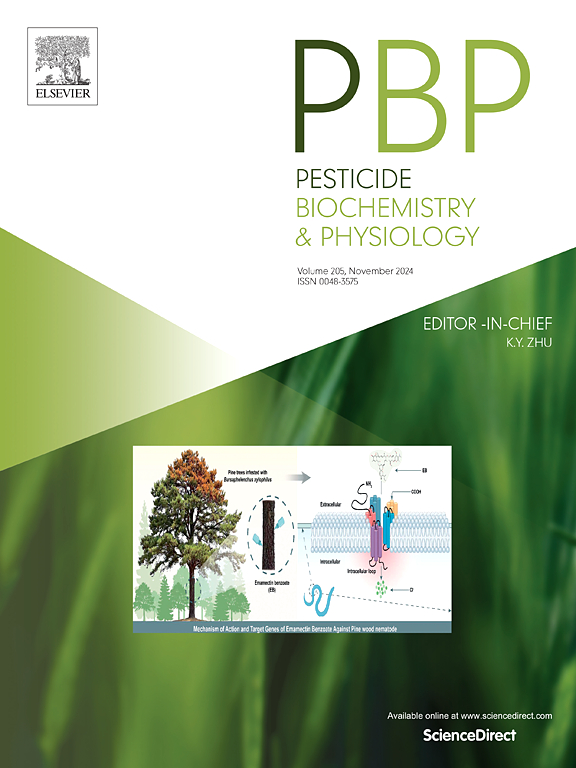Functional analysis of Ophraella communa Lesage OcomOBP11 in recognition of Ambrosia artemisiifolia L. volatiles
IF 4.2
1区 农林科学
Q2 BIOCHEMISTRY & MOLECULAR BIOLOGY
引用次数: 0
Abstract
Odorant binding proteins (OBPs) play a critical role in insect survival by facilitating the detection of environmental odors. This study identified and characterized OcomOBP11 in the leaf beetle Ophraella communa Lesage. Sequence and phylogenetic analyses demonstrated that OcomOBP11 belongs to the Minus-C OBP family. Tissue-specific expression analysis revealed that OcomOBP11 showed the highest relative expression in the testis. Functional assays demonstrated that OcomOBP11 has strong binding affinity to 24 of the 26 volatiles from Ambrosia artemisiifolia L., a primary host plant. Molecular docking showed that OcomOBP11 formed hydrophobic interactions with β-caryophyllene, α-pinene, camphene, octanal, and nonanal and hydrogen bonds with octanal and nonanal. RNAi-mediated knockdown of OcomOBP11 significantly reduced the electrophysiological (EAG) response and behavioral preference of O. communa for these ligands. These findings suggest that OcomOBP11 plays an important role in host plant localization, thus providing guidance for future biological invasion control strategies.

鸢尾草OcomOBP11识别艾草挥发物的功能分析
气味结合蛋白(OBPs)通过促进环境气味的检测,在昆虫的生存中起着至关重要的作用。本研究鉴定了叶甲虫(Ophraella communa Lesage)中的OcomOBP11基因。序列和系统发育分析表明,OcomOBP11属于- c OBP家族。组织特异性表达分析显示,OcomOBP11在睾丸中相对表达量最高。功能分析表明,OcomOBP11对主要寄主植物Ambrosia artemisiifolia L. 26种挥发物中的24种具有较强的结合亲和力。分子对接表明,OcomOBP11与β-石竹烯、α-蒎烯、莰烯、辛醛和壬醛形成疏水相互作用,并与辛醛和壬醛形成氢键。rnai介导的OcomOBP11敲低显著降低了O. communa对这些配体的电生理(EAG)反应和行为偏好。这些结果表明,OcomOBP11在寄主植物定位中发挥着重要作用,从而为未来的生物入侵控制策略提供指导。
本文章由计算机程序翻译,如有差异,请以英文原文为准。
求助全文
约1分钟内获得全文
求助全文
来源期刊
CiteScore
7.00
自引率
8.50%
发文量
238
审稿时长
4.2 months
期刊介绍:
Pesticide Biochemistry and Physiology publishes original scientific articles pertaining to the mode of action of plant protection agents such as insecticides, fungicides, herbicides, and similar compounds, including nonlethal pest control agents, biosynthesis of pheromones, hormones, and plant resistance agents. Manuscripts may include a biochemical, physiological, or molecular study for an understanding of comparative toxicology or selective toxicity of both target and nontarget organisms. Particular interest will be given to studies on the molecular biology of pest control, toxicology, and pesticide resistance.
Research Areas Emphasized Include the Biochemistry and Physiology of:
• Comparative toxicity
• Mode of action
• Pathophysiology
• Plant growth regulators
• Resistance
• Other effects of pesticides on both parasites and hosts.

 求助内容:
求助内容: 应助结果提醒方式:
应助结果提醒方式:


